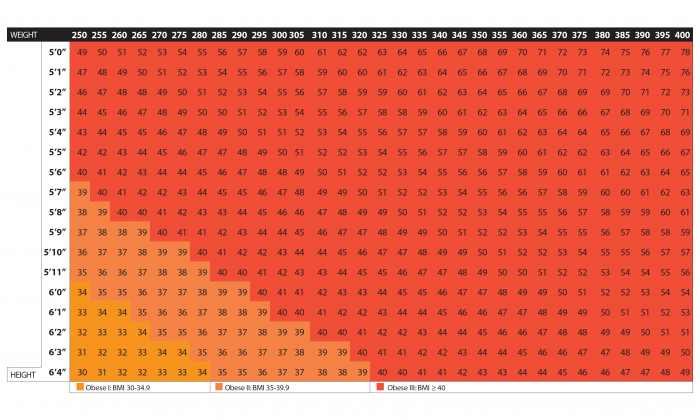Body Mass Index Calculator

Most people into fitness today regularly use a more sensitive indicator to measure how heavy their body weight is. This indicator is called body mass index (BMI). Interestingly, those into full-time bodybuilding or those with a large amount of muscle mass tend to find the use of BMI for calculating their overall fitness quite ineffective. BMI is mostly used by average individuals who are just more concerned about their body weight and fitness level.
What is BMI (Body Mass Index)

The Body Mass Index is a single value that determines if an individual is underweight or overweight based on the individual's weight and height measurement. BMI was discovered by Adolphe Quetelet, and was meant to evaluate the body weight of a person.
BMI is generally used as the first indicator in determining body fat. This method has been the most widely used for tracking weight problems and obesity among adults over the years.
BMI is a mathematical formula in which an individual's body weight measured in kilograms (if using metric) or pounds (if using imperial) is divided by the square of his or her height in centimeters (if using metric) or feet (if using imperial) - wt/(ht)2.
The BMI is more highly compared with body fat rather than any other indicator like the height and weight. The calculation for obesity is the same for both men and women. For instance, a person who is 5' is obese at 182 pounds, and a person who is 6' is obese at 220 pounds.
What is my BMI?
Use our BMI calculator below to calculate your BMI.
[CP_CALCULATED_FIELDS id="1"]
What is the healthiest BMI to have?
According to the Centers for Disease Control and Prevention and the World Health Organization's current guidelines, if the body mass index is below 18.5, the person is considered to be underweight. From 18.5 to 24.9, the weight is absolutely normal. A BMI of 25 and above, caution is recommended and a slight tendency to being overweight may be established. BMI values above 30 indicate problems and must be taken seriously, since they are already in the obese range.
The BMI takes the age of the person into account. The normal value of those under 30 years old lies below that of older people. In addition, gender plays an important role. The BMI among men is considerably higher than among women, this is due to the greater muscle mass with men.
Constant monitoring of weight is important, especially among children and adolescents. Many of them tend to be slightly overweight even at a young age, which has a negative impact on bones and health development.
How is BMI Calculated
The BMI is calculated using the below equations in both the imperial measurement (still be used in the UK) and the metric system (used globally) using the following values for the calculation; Height: 5'10", Weight: 160lbs:
Metric Measurement:
BMI = mass(kg)/height2 (m)
- You need to first convert lbs to kg, so 160lbs is 72.58kg
- Next convert 5ft 10in to meter, first we convert 5'10" to inches. This will be (5x12in) + 10in = 70in. Next convert inches to meter and the result for 70in will be 1.78meters
- Now multiple 1.78 by itself = 1.78x1.78 = 3.17meters
- Divide 72.58(kg) by 3.17m = 22.90
- So the BMI value is 22.90 (This is normal weight)
Imperial Measurement:
BMI = 703 × mass(lb)/height2 (in)
- First convert 5ft 10in to inches, same as above, the result is 70in
- Now multiple 70in by itself. 70inx70in = 4900in
- Divide the mass by the result from last step. 160lb/4900in = 0.03
- Now multiply the above result by 703. 703 x 0.03 = 21.09 (This is normal weight)
Note: Please note that your BMI result will vary depending on the structure of your body. A person with more muscles will tend to have a higher BMI even when they are healthy, since muscle weighs more than fat. So the BMI result should only be used as a guide and not a replacement for your medical advise received.
Body Mass Index Chart:
Below is the body mass index charts. Use this chart as a guide to determine if you are underweight or overweight. As earlier mentioned, this would defer based on your muscle weight especially for athletes.
Weight between 95 and 245 pounds

Weight between 250 and 400 pounds

BMI Categories
BMI less than 18.5
If your BMI result is below 18.5, this indicates that you are underweight. Being underweight may indicate you are not eating enough, or possible underlying medical condition. You are advised to look into gaining some weight. Always consult your doctor or a dietitian for further advice.
BMI between 18.5–24.9
If your BMI result falls between 18.5–24.9, this indicates that you have a healthy weight. Maintaining a healthy weight lowers the risk of developing any serious health challenges.
BMI between 25–29.9
If your BMI result falls between 25–29.9, this is an indication that you are slightly overweight. The general advise would be for you to lose some weight. As always, its important you seek the advise of your doctor or a dietitian before embarking on any weight loss program.
BMI over 30
If your BMI result is over 30, this is a indication that you are obese or heavily overweight. Studies shows that people with such high BMI results are at risk of developing a health problem. You are highly recommended to seek your doctor's advice or consult the help of a nutritionist.
What happens when your BMI is low?
A low BMI indicates you are underweight and that itself comes with its own health risk depending on individual. According to studies, some of the health risk associated with low BMI includes:
- increased risk of complications during medical surgery
- decreased immune system function
- deficiencies in vitamins, malnutrition, anemia e.t.c
- fertility issues as a result of irregular menstrual cycles
Conclusion
The key main benefit of the BMI index is to point out and warn us of possible overweight. The risk of being overweight is constantly increasing among people worldwide at a fast pace. The BMI takes into account the individual's weight, but not the composition of muscle and fat tissue. The index is simply calculated by the weight divided by the square of the body height. This calculation produces a number that gives information about your weight status.

Related Posts